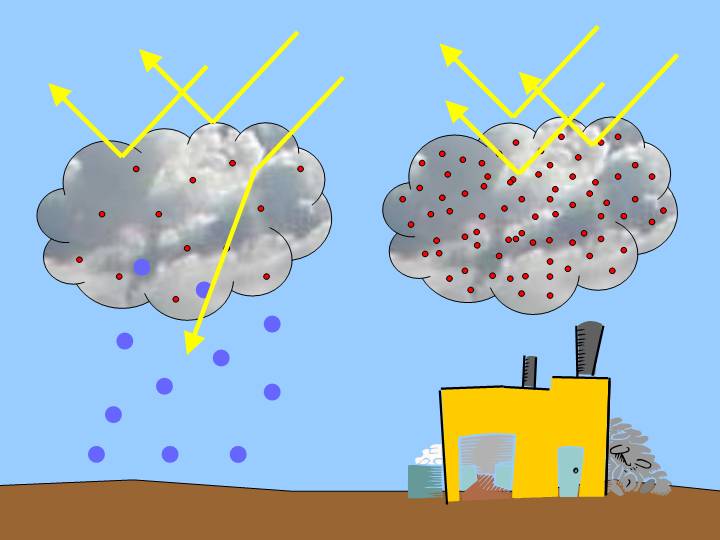|
|
 |
|
|
|
 |
| |
|
|
 |
Clouds and particles
More |
Particles and Climate
We have seen in the Basics section "Clouds and Climate" that clouds affect climate. First, they send back to space one part of the solar energy reaching our planet (about 30% of the sunlight is reflected). Second, they trap infrared radiations coming from Earth's surface, therefore allowing our planet to keep a part of the heat released.
|
|
|
|
|
 |
|
But what is the role of particles in the climate system? Do they modify the amount of energy reaching the ground in the absence of clouds?As they allow clouds to form, do they have an impact on the future behaviour of a cloud?
Direct effect of particles on climate
Particles scatter and absorb the light; this is why they modify the visibility. But this process has also an influence on climate, as aerosols can reduce the amount of solar energy that reaches the ground.
|
In 1783, a strong volcanic eruption occured in Iceland. The famous scientist Benjamin Franklin observed "a dry fog" over France, and hypothesized that the severe winter in Europe that year was linked to this "dry fog". A magnifying glass wouldn't even burn paper, he said. Franklin suggested that there was a reduction in the amount of solar energy received at the Earth’s surface after the volcanic eruption.
Similarly, extinction of dinosaurs is supposed to be the result of a meteor impact 60 millions years ago. That massive collision injected so huge amounts of aerosols in the atmosphere that sun was masked during several months, causing severe cooling at the Earth's surface.
|
 |
 |
 |
|
1. American scientist Benjamin Franklin (1706 - 1790). Source: www.nps.org
|
|
|
Simulations and observations after the Mount Pinatubo erupt have shown a cooling of the planetory global temperature of 0.5°C.
Direct effect of particles on climate, i.e. the scattering of solar radiation, leads to a global cooling effect.
|
 |
 |
|
2. Haze over China. The haze is the result of forest fires, the burning of agricultural wastes, dramatic increases in the burning of fossil fuels in vehicles, industries and power stations and emissions from millions of inefficient cookers burning wood, cow dung and other 'bio fuels'. Source: UNEP, NASA.
|
|
 |
Human influence on the direct effect of aerosols
Because of their activities (industrial activities, burning of fossil fuels in vehicles, forest fires...), humans can emit strong quantities of particles in the atmosphere. For example, a three kilometer-deep pollution blanket being called the "Asian Brown Haze" stretches across South Asia, modifying weather patterns and endangering the health of hundreds of thousands of people. This mass of aerosols is reducing the amount of sunlight or solar energy hitting the Earth's surface by as much as 10 to 15 per cent.
But aerosols have also an indirect effect on climate, and our planet hasn't heard the last of humans... |
Indirect effect of particles on climate
Indirect forcing by aerosols is defined as the overall process by which aerosols perturb the Earth-atmosphere radiation balance by changing the cloud albedo and cloud amount. Indirect climate effects of aerosols are more difficult to assess than direct effects. They involve the relationship between aerosols properties and cloud's characteristics:
Therefore, a change in number and size of particles leads to a change in Cloud Condensation Nuclei concentrations. Such modifications cause changes in population and size of cloud's droplets, which are expected to cause changes in cloud albedo.
Human influence on indirect effect of particles
Anthropogenic emissions produce a greater amount of small particles. Thus, anthropogenic aerosols are believed to have two major effects on cloud properties:
First, the increased number of CCN results in a larger number of smaller cloud droplets. Scattering of light within clouds is enhanced, thus increasing the cloud albedo.
Second, as droplets are smaller, precipitation is lowered, thus increasing cloud lifetime and the average cloud cover on Earth.
Both effects reduce the amount of sunlight absorbed by Earth and thus tend to cause global cooling. |
Figure 3. shows the indirect effect of particles: polluted clouds send more solar radiation back to space, and rainfall is inhibited because of the smallest sizes of droplets within the cloud.
|
 |
 |
 |
|
3. Human influence on the indirect effect of aerosols. Author: J. Gourdeau.
|
|
|
However it remains great uncertainties about that indirect forcing of aerosols, because the pathways from particles to cloud's albedo are complex.
By these direct and indirect forcing, particles play a role in the radiation budget of our planet.
More details on albedo are given in the Basics, Unit 3.
About this page....
Author: J. Gourdeau, LaMP Clermont-ferrand, France.
Scientific reviewing: Dr Vincent Giraud, LaMP France.
Date of creation: 2004-01-19. Last published: 2004-04-26. |
|
 |
|









